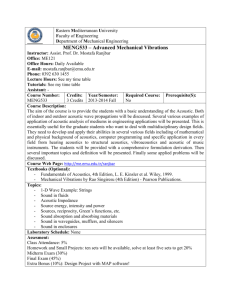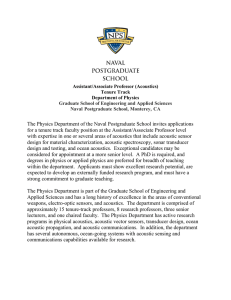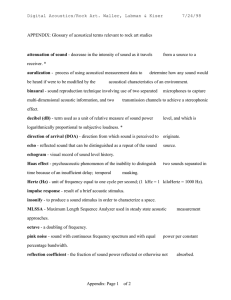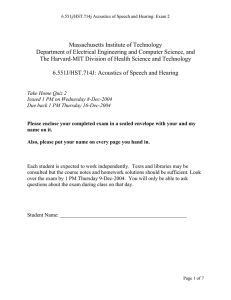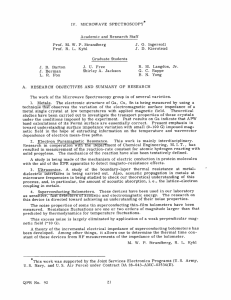Lecture 11 Acoustics of Speech & Hearing 6.551 - HST 714J
advertisement
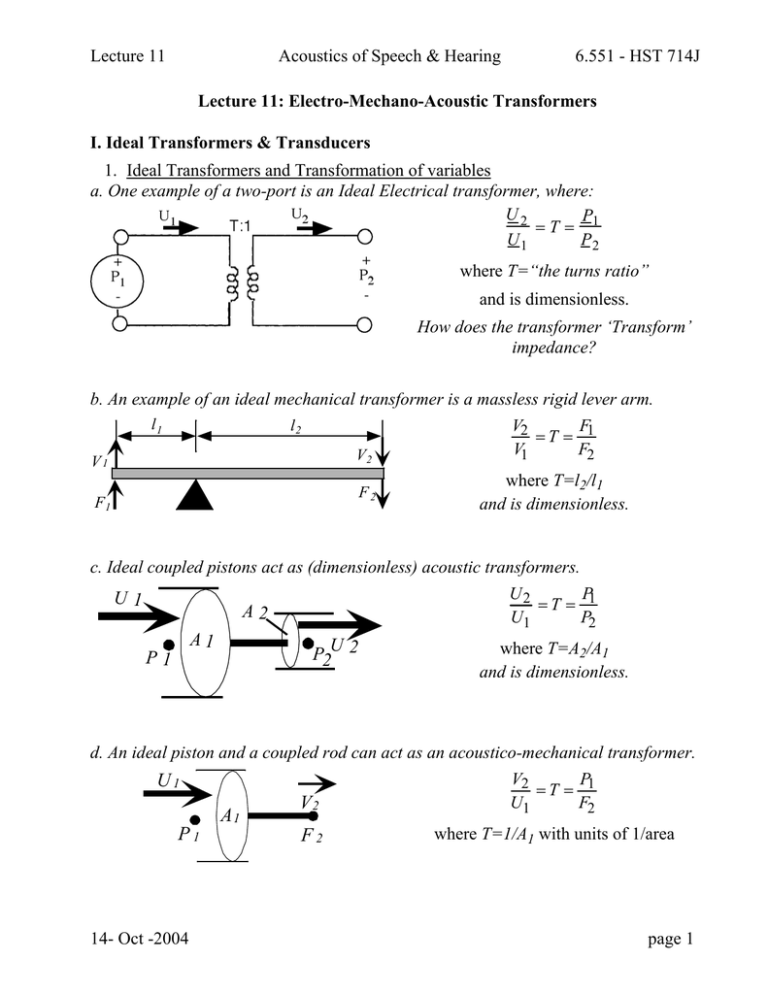
Lecture 11 Acoustics of Speech & Hearing 6.551 - HST 714J Lecture 11: Electro-Mechano-Acoustic Transformers I. Ideal Transformers & Transducers 1. Ideal Transformers and Transformation of variables a. One example of a two-port is an Ideal Electrical transformer, where: U2 P =T= 1 U1 P2 where T=“the turns ratio” and is dimensionless. How does the transformer ‘Transform’ impedance? b. An example of an ideal mechanical transformer is a massless rigid lever arm. l1 l2 F V2 =T = 1 F2 V1 V2 V1 F2 F1 where T=l2/l1 and is dimensionless. c. Ideal coupled pistons act as (dimensionless) acoustic transformers. U1 P U2 =T = 1 P2 U1 A2 A1 P1 P2U 2 where T=A2/A1 and is dimensionless. d. An ideal piston and a coupled rod can act as an acoustico-mechanical transformer. V2 V2 P =T = 1 U1 F2 F2 where T=1/A1 with units of 1/area U1 A1 P1 14- Oct -2004 page 1 Lecture 11 Acoustics of Speech & Hearing 6.551 - HST 714J e. A first order model of the vertebrate middle ear is as an acoustic transformer that couples acoustic power from air to the fluid-filled inner ear. U1 A2 P1 A1 P2U 2 U2 P =T = 1 U1 P2 A cross-section through half a lizard head DORSAL SURFACE (TOP OF THE HEAD) SINGLE OSSICLE BONEY SKULL MIDDLE EAR AIR SPACE TWO WINDOWS TYMPANIC MEMBRANE In the lizards the tympanic membrane is about 20 times larger in area than that of the boney footplate of the ossicle (the wide part that couples to one of the inner ear windows). This leads to a transformer ratio of 1/20 that would suggest. U 2 V A FP 1 . = ≈ U 1 V ATM 20 INNER EAR The Impedance transformation ratio is T2=1/400: If THROAT P2 P1 = 400; =1 U2 U1 The acoustic transformer trades a change in volume velocity for a change in pressure of opposite magnitude. As we will see in the next two lectures, the ideal transformer is an idealization in the real world it’s difficult to build a massless, rigid piston that is perfectly mobile. 14- Oct -2004 page 2 Lecture 11 Acoustics of Speech & Hearing 6.551 - HST 714J 2. The microphone. An acoustic – mechanical – electric transducer a. The capacitive microphone The signal flow through a capacitive microphone can be separated into three separate stages: - An Acoustic stage that generates the acoustic input signal: - A Mechanical stage that gathers the force produced by the acoustic signal - An electric system that transforms mechanical force and motion into voltage and current Acoustical System Mechanical System The heart of an electro-static transducer is Fixed Plate V I F E + – Electrical System Moving Plate a charged capacitor with a fixed internal plate and a moving external plate where the capacitance depends on the distance between the plates and the distance is a function of the voltage across the plates. Such a transducer acts as an : electromechanical transformer such that V E = TES = I F x0 (the static separation of the plates) where TES = C 0 (static capaci tan ce)E 0 (static voltage) 14- Oct -2004 page 3 Lecture 11 Acoustics of Speech & Hearing 6.551 - HST 714J when the voltage induced variations in x, C and F are small. Input voltages produce a force on and velocity of the moving plate (or diaphragm) that when integrated over the surface of the moving plate produce a volume velocity and a sound pressure. 14- Oct -2004 page 4 Lecture 11 Acoustics of Speech & Hearing 6.551 - HST 714J b. A Low-Frequency Model of the Electrostatic Microphone: In the electrostatic microphone, the microphone acts simply as long as the capacitance of the diaphragm and backplate CE controls the electrical stage and the compliance of the diaphragm CM controls the mechanical stage. In our circuit, CM is placed in series with the acoustic source, since the force and motion is gathered by motion of the diaphragm. CE is placed in parallel because it represents the static electrical capacitance which is their even when the diaphragm is fixed and V and I =0. Expensive ‘capacitive’ microphones with small (high-impedance) capacitance and stiff (low compliance) membranes are used as “STANDARD MICROPHONES” throughout the world. What is the Thevenin impedance of the microphone measured at its output electrical port? With the sound source turned off: E′ 1 1 E 2 Z TH ( ω ) = = in parallel with T M E − I ′ jωC E jωC M ( ) = 1 ⎛ ⎞ ⎜ CM ⎟ jω ⎜ C E + 2⎟ E ⎜ TM ⎟ ⎝ ⎠ What is the Thevenin voltage equivalent to a sound pressure of P? ( ) 14- Oct -2004 page 5 Lecture 11 Acoustics of Speech & Hearing E TH (ω ) = = 14- Oct -2004 P E TAM TM P E TAM TM 6.551 - HST 714J 1 ( jωC E ) ( ) E 1 ( jωC E ) + TM 2 ( jωC M ) 1 CE ( ) E 1 C E + TM 2 CM page 6 Lecture 11 Acoustics of Speech & Hearing 6.551 - HST 714J 3. Reciprocity Revisited We have already given you a formal definition of reciprocal networks in terms of constraints placed on two-port network parameters, e.g. in the case of a two-port electrical network coupled to two voltage sources: I I I1 = Y11E1 + Y12 E 2 I2 = Y21E1 + Y22 E 2 When E1 is set to 0: I1 = Y12 E2 ; while when E2 is set to 0: I2 = Y21E1 . If the system is made up of passive RLCs and transformers, then the system is reciprocal and Y12 = Y21. This means you can couple up a known voltage source to one side of the network and measure the same current on the other side of the network, no matter which side you couple to the source. Given the ‘Admittance description of the two-port on the previous page: I1 = Y11 E1 + Y12 E 2 Eqn 11.1 I2 = Y21E1 + Y22 E 2 Let’s fix I1 with a current source while setting I2 = 0, i.e. opening the circuit at port 2. The relationship between I1 and E2 can be defined from Eqns 11.1 Since I2 = 0; Substituting into 11.1A yields Y E1 I =0 = − 22 E 2 2 Y21 (11.2) ⎛ Y Y ⎞ I1 I =0 = E2 ⎜Y12 − 11 22 . 2 Y ⎝ ⎠ (11.3) 21 14- Oct -2004 page 7 Lecture 11 Acoustics of Speech & Hearing 6.551 - HST 714J Now lets fix I2 with a current source while setting I1 = 0, i.e. opening the circuit at port 1. The relationship between I2 and E1 can be defined from Eqns 11.1 as ⎛ Y Y ⎞ I2 I =0 = E1⎜Y21 − 11 22 ⎟ . (11.4) 1 Y12 ⎠ ⎝ If reciprocity holds: Y21=Y12=YR, and E E2 = 1 I1 I =0 I2 1 (11.5) Y Y I 1 =0 Y − 11 22 2 R YR Note that this reciprocal relationship only works for specific combinations of sources and port measurements. = 1. Acoustic Reciprocity Acoustic Reciprocity, as strictly defined by Lord Rayleigh, says that in a given environment, if a spherical sound source of strength U is placed at position 1 (x1,y1,z1) and the sound pressure at some position 2 (x2,y2,z2) is P, then placement of the same sound source at position 2, will produce a sound pressure of P at position 1. 14- Oct -2004 page 8 Lecture 11 Acoustics of Speech & Hearing 6.551 - HST 714J 4. The Electro-Static Speaker I + E – + – I' ZE B T E S:1 V + F – A:1 ZM S + F2 – U + P – ZA R The diagram above is a schematic representation of all of the processes involved in the production of sound by the electrostatic speaker. 1. The right most segment of the circuit describes the relationship between the volume velocity U and sound pressure P produced by the source and the acoustic radiation impedance ZAR. 2. The right most transformer describes the transformation of the force and the velocity produced by the moving plate of the transducer to volume-velocity and sound pressure and has units of area. Z AR = P U F U =A= 2 V P 3. The middle mechanical-impedance describes the force necessary to move the outer plate with a given velocity. Z MS = 4. The left hand transformer describes the transformation between voltage and force and current and velocity by the electro-static mechanism. E V = TES = F I' 5. The left-most impedance block describes the electrical impedance when the outer plate is fixed and cannot move. Z EB = F − F2 V E I V =0 Note that the total electrical impedance seen at the voltage source varies as the outer plate moves and depends on the impedances of the mechanical and acoustic components 14- Oct -2004 page 9 Lecture 11 Acoustics of Speech & Hearing ZE = ( V = Z EB //T 2 Z MS + A 2 Z AR I ( ) = Z EB + T 2 (Z MS + A2 Z AR ) Z EBT 2 Z MS + A 2 Z AR 14- Oct -2004 6.551 - HST 714J ) . page 10 Lecture 11 Acoustics of Speech & Hearing 6.551 - HST 714J If we assume: -the electrical impedance is primarily capacitive -the mechanical impedance is primarily determined by the compliance of the diaphragm, and -the acoustic impedance is a radiation impedance, We can model the electrostatic speaker with this relatively simple circuit. I + E – + – T E S:1 V CE + F – CM A:1 + F2 – U + P MA – RA . At low frequencies the Ratio of transfer ratio of P/E is determined by the compliance of the diaphragm CM, and the acoustic mass. At high frequencies the pressure-tovoltage ratio depends on the area of the diaphragm A, and the electro-static transducer constant TES. The Radiation Impedance Radiation jω M A R A P = U jωM A + R A The Mechanical Impedance with ⎛ ⎞ F 1 2 jω M A R A ⎟⎟ = + A ⎜⎜ V jωC M ⎝ jω M A + R A ⎠ Sound Pressure / Force ⎛ ⎞ ⎛ jωM A R A ⎞ ⎜ ⎟ A 2 ⎜⎜ ⎟⎟ ⎟ P 1⎜ ⎝ jωM A + R A ⎠ = ⎜ ⎛ ⎞⎟ F A⎜ 1 2 jωM A R A ⎟ ⎜ jωC + A ⎜⎜⎝ jωM + R ⎟⎟⎠ ⎟ ⎝ M A A ⎠ Sound Pressure / Volt ⎞ ⎛ ⎛ jω M A R A ⎞ ⎜ ⎟ A 2 ⎜⎜ ⎟⎟ ⎟ P 1 1⎜ ⎝ jωM A + R A ⎠ = ⎜ ⎛ ⎞⎟ E TES A ⎜ 1 2 jω M A R A ⎟ ⎜ jωC + A ⎜⎜⎝ jωM + R ⎟⎟⎠ ⎟ ⎝ M A A ⎠ ⎞ P 1 1 ⎜⎛ −A 2 ω 2 M A R A C M ⎟ or = E TES A ⎜⎝ −A 2 ω 2 M A R A C M + jωM A + R A ⎟⎠ Sound Pressure / Volt (Approximates) 14- Oct -2004 page 11 Lecture 11 P E = small ω Acoustics of Speech & Hearing ( ( 1 2 2 −ω C M A M A A TES )) P E = large ω 6.551 - HST 714J 1 A TES . Electro-Static Speaker Characteristics ZmRad ZmComp ZmTotal P/E Magnitude Mechanical Ohms or Pa/Volts 100 10 1 0.1 10 100 1000 10,000 Frequency (Hz) Assumes: TES=1 A = π (0.1)2 m2 RA and MA defined by radius CM= 3x10-5 m/N 14- Oct -2004 page 12 Lecture 11 Acoustics of Speech & Hearing 6.551 - HST 714J 5. The Electro-Dynamic Speaker The Electrodynamic speaker usually uses magnetic force to move a light-weight diaphragm. The diagram below shows the magnet (PM), the current input to the ‘voice coil’ (VC) in the magnetic field, and the attachment of the paper cone PC to the coil. B: Magnetic Flux Density PM: ringed Permanent Magnet BP: Base Plate PP: Pole Piece CP: Cover Plate VC:Voice Coil SP: Spider (supports the voice coil) PC: Paper Cone DC: Dust Cover CS: Cone Support from FV Hunt “Electroacoustics” Acoustical Society of America 1982 Courtesy of Acoustical Society of America. Used with permission. In generating an electrical analog of electro-acoustic transduction in the electrodynamic speaker, it is still convenient to break the system into electrical; mechanical and acoustical sections that are connected by ‘ideal’ transducers modeled by transformers with dimensions. Something new in the model below is that alternating current in a magnetic field produces an electromotive Force. This proportionality between current and force leads to the use of the electrical-mechanical admittance analogy where force and sound pressure are analogous to current, and velocity and volume velocity are analogous to voltage. 14- Oct -2004 page 13 Lecture 11 Acoustics of Speech & Hearing 6.551 - HST 714J Because of this change in analogies, the acoustical and mechanical boxes are defined by impedance elements with values of 1 over the mechanical and acoustical impedances, and the electrical impedance ZEB (measured when the speaker cone is fixed in place) is in series with the voltage source. 1. The Effect of Speaker Enclosures The box around a speakers serves to increase the output power of the sound by making the moving cone a monopole source. However, in doing so it places some acoustic-mechanical constraints on the motion of the diaphragm. 1 jωM A R A P + = U jωM A + R A jωC Box These constraints can be modified by use of openings in the speaker cabinet, as in bass-reflex speakers. 14- Oct -2004 page 14

